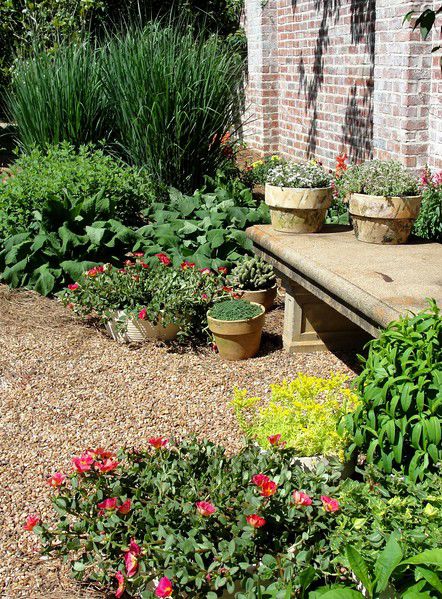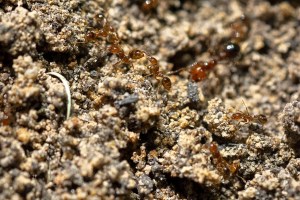The more plants, the better is not good landscape design
Published 11:27 am Thursday, April 6, 2017

- COURTESY This well-designed landscape features ornamental grasses softening an antique bench and pots.
I was born in love with plants. After all, I was appointed keeper of the class terrarium in first grade then decided on a career in horticulture after reading a book about George Washington Carver in the fourth grade. Next was a large vegetable garden, then a greenhouse while I was in junior high. Finally, it was off to Texas A&M to study horticulture so I could learn to grow as many different kinds of plants as possible.
As you probably already know, that is the unintended goal of most gardeners. We collect as many plants as we can, then feverishly try to find places to grow them in our landscapes. Not only do friends give them to us, but we actively purchase every pretty thing that catches our eye. The entire nursery industry is built around these impulse purchases.
Trending
Naturally, this creates a problem. When painting a picture, you don’t purchase every color in the store that catches your eye, then go home and force them all onto a palette. And when cooking, one doesn’t go to the grocery store and load up on as many things as possible, then come home and try to form them into an edible dish. I’ve always said, cramming a bunch of different plants into a garden and hoping it will be a fine landscape is like tossing a bunch of ingredients into the oven and hoping a pie jumps out. There has to be a plan.
Collecting plants is a fun endeavor, but shouldn’t be confused with landscape design. I’d like to share quotes from famous landscapers about using too many different kinds of plants in a landscape:
“I am strongly of the opinion that the possession of a quantity of plants, however good the plants may be themselves and however ample their number, does not make a garden; it only makes a collection. Having got the plants, the great thing is to use them with careful selection and definite intention. Merely having them, or having them planted unassorted in garden spaces, is only like having a box of paints from the best colourman, or to go one step further, it is like having portions of these paints set out on a palette. This does not constitute a picture; and it seems to me that the duty we owe to our gardens and to our own bettering in our gardens is so to use the plants that they shall form beautiful pictures; and that, while delighting our eyes to a more exalted criticism; to a state of mind and artistic conscience that will not tolerate bad or careless combination or any sort of misuses of plants, but in which it becomes a point of honour to be always striving for the best.
“It is in the way it is done that lies the whole difference between commonplace gardening and gardening that may rightly claim to rank as fine art. Given the same space of ground and the same material, they may either be fashioned into a dream of beauty, a place of perfect rest and refreshment of mind and body – a series of soul-satisfying pictures – a treasure of well-set jewels; or they may be so misused that everything is jarring and displeasing. To learn how to perceive the difference and how to do right is to apprehend gardening as a fine art.”
Gertrude Jekyll, “Colour in the Flower Garden,” 1908
“It is wrong to think that landscaping is a collection of specimens from all parts of the world. Museums are not made to live with. The finding of plant varieties is a scientific venture, fine and noble in itself, but is must not be confused with art, as is so often done. To be inspired by and to create parks and gardens out of the beauty and composition of our native landscape is a much higher accomplishment than to form a garden with varieties of plants that have no association with each other or with us and which at best become mere patch work influences by the curious and scientific mind.”
Trending
Jens Jensen, “Siftings,” 1939.
“However much space any gardener has, there is never enough to grow all the plants on offer. The temptation is always to try to fit in everything seen or read about until there is no more room. Respecting some unity of purpose is not a hindrance: by imposing discipline it distils the effect of the garden and so creates more than just a collection of plants. It also transforms a garden into a place to be, rather than one that is there just to be looked at.”
Mary Keen, “Creating a Garden,” 1996
I have two confessions to make. I am a plant collector myself. Thankfully, I’m recovering after years of therapy. Also, horticulture wasn’t my only true love. I also wanted to be a chef and an artist. That’s one reason I chose horticulture as a profession because it easily incorporates those two as well. I remember how satisfied I was in a freshman horticulture class at Texas A&M when the professor said that horticulture was half science and half art. Hooray for both!
Unfortunately many in the profession don’t engage the art aspect. I, on the other hand, dearly love it. I can thank my mentor Dr. William C. Welch for my deep interest in the actual art of landscape design. I first went into the profession with a bit of a cooker-cutter mentality and a limited plant palette. But Bill showed me many meaningful, soulful, thoughtful, interesting, artistic, as well as functional designs. I was hooked.
I then proceeded to tour European gardens where the art had been practiced successfully for hundreds of years. Then it finally clicked. All of these beautiful gardens had some common traits. They are known as basic design principles. For hundreds of years, landscape designers have used these basic tools to create a beautiful array of masterpieces, and it was obvious that I needed to learn them, too. Unfortunately, no two experts agree on which ones are the most essential. So I spent more time distilling them down to the five I considered absolutely essential to producing good landscapes. They are extremely important in all design, not just landscaping. Design is design, whether it be landscape, floral, interior or fashion. So as you go through each day, pay attention to the design details of the spaces around you. They will help you figure out your landscape personality as well. No two landscapes should be the same, just as no two people are the same. There’s plenty of room for creative freedom in landscape. The basic design principles are just guidelines to establish parameters for your work.
Greg Grant is the Smith County horticulturist for the Texas A&M AgriLife Extension Service. You can follow him on Facebook at Greg Grant Gardens, read his “Greg’s Ramblings” blog at arborgate.com or read his “In Greg’s Garden” in each issue of Texas Gardener magazine (texasgardener.com). For more information on local educational programming, go to smith.agrilife.org.





